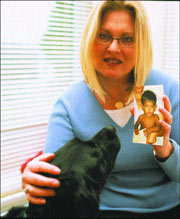ON FRIDAY, March 1, Melanie Curtright finally got some good news. The 42-year-old Microsoft executive learned that she was among the parents whose long-planned adoptions of Cambodian orphans could proceed. But on the same day, Ellen Skugstad, also 42 and the owner of Seattle photography business Redfish Kids, found out that she’s on the slow track to get the visa required to bring her Cambodian orphan home.
The announcement that the U.S. Immigration and Naturalization Service (INS) would grant humanitarian visas to as many as 200 Cambodian orphans slated for U.S. adoption is a bittersweet milestone in what, for many parents, has been a long and protracted process. Nearly three months ago, the INS suspended all adoption from Cambodia so it could investigate baby trafficking. According to INS statements, a Cambodian organization stole two babies and created false papers for them; as a result, one nearly received a visa for American adoption. Effective Dec. 21, 2001, Americans can no longer apply to adopt Cambodian children. Adoptions already in progress, like Curtright’s and Skugstad’s, were postponed until further notice.
A total of 500 Cambodian orphans are affected by the suspension, but the INS plans to deal with only the 200 best-documented cases first. These are the cases—according to joint reviews conducted by the INS, the U.S. State Department, and the Cambodian government—with little trafficking risk. While parents in the first 100 cases under INS review could bring their children home as soon as April (with the other 100 children coming sometime thereafter), anxiety created by the delay hasn’t ebbed. At least six Seattle families, along with the local adoption agency handling their cases and 30 others in the U.S., have lived for months at the center of an international investigation into human rights abuses that could involve the children they plan to make family.
CURTRIGHT KNOWS that she’s one of the luckier parents, though she remains wary. “I won’t feel good about it until I’m on a Seattle-bound plane going home with him,” she says of baby Piseth, whom she will rename Nicholas. “My heart is breaking for people who got referrals [for children] around the time that I did and who may not get to pick up their children,” she says. And her own optimistic prognosis doesn’t diminish her disgust at the suspect facilitators in Cambodia—and the U.S. adoption agencies who used them. “I feel for the American families; they are innocent victims like the children,” she says. “But I am so angry at the agencies that use [facilitators accused of trafficking] and who brought this down on all of us.”
In 2000, Seattle International Adoptions (SIA), a Mercer Island agency, handled nearly 30 percent of Cambodian adoptions in the U.S. Last year, executive director Lynn Devin placed 120 Cambodian orphans into American homes, but now she’s running interference nationwide on the “pipeline” cases (in progress prior to Dec. 21) affected by the suspension. If the suspension continues, she’ll be out of the adoption business. According to Devin, three of her Seattle families (including Curtright) are among the first 100 cases, and another three (including Skugstad) are not so lucky.
Skugstad was matched with Lysna, a 22-month-old girl whom she plans to name Pia Marie, back in October. As of this week, her case is among the last 300 the INS plans to address. She risks seeing her adoption drag on for several more months, or not happen at all. “It wasn’t an easy weekend,” said Skugstad on the Monday after the announcement. “I’m in a gray area.”
SIA clients Kim Tosch-Berneburg and Jay Berneburg, a 40-something Tacoma couple already raising two domestically adopted teens and a Chinese toddler, also appear to be among the less fortunate 300 cases in limbo. At SIA they were able to secure a referral for a 22-month-old child in October. But through a comedy of errors overseas, many papers required in Cambodia ended up in China—and last week the Berneburgs also learned that the INS may consider some of their paperwork expired, which the family plans to contest. “The situation is unbelievable,” says Tosch-Berneburg, who, ironically, completed a bachelor’s degree in international studies at the University of Washington in Tacoma last year.
WHILE THE PIPELINE families wait to get children out of Cambodia, the broader question is when—and whether—Cambodia will revise its adoption process to meet INS standards and get the suspension lifted. “We’re not able to anticipate how long this is going to take,” says INS spokesperson Bill Strassberger. “But we’re thinking it could be a year.”
Strassberger says one model for regulation comes from the 1993 Hague Convention on Intercountry Adoption. Signed by more than 60 nations, it suggests standards for how an orphan’s country of origin and receiving country verify the child’s legitimate availability and manage related paperwork.
In the context of other international adoption programs available to Americans, the Cambodian program is one of the smallest. Of the 18,500 foreign children adopted by U.S. parents during 2000, only 402 came from Cambodia, according to State Department figures provided by the INS. China and Russia, whose programs are among the oldest, accounted for 5,000 and 4,000 adoptions, respectively. But Cambodia’s program is one of the youngest, with the first overseas adoptions out of Cambodia taking place in 1990 and no formal U.S. agency programs in place until 1997, when SIA formed.
The relative youth of the Cambodian adoption system—which requires paperwork and government approval from four separate ministries—may explain why the system is still not entirely consistent. Devin’s sister Lauryn Galindo essentially launched overseas adoption programs in Cambodia around 1990, working on grassroots placements of about 80 children that year—at times airlifting them out of danger zones or riding alongside drivers through gunfire.
“My sister’s a pretty amazing woman,” Devin says. By 1997, Galindo had convinced Devin—a licensed social worker with paralegal experience at a law firm that handled adoptions—to collaborate with her from America. Devin opened SIA, and the two have worked together ever since on Cambodian adoption as well as food and medical aid programs that continue to operate during the suspension.
Devin is unsure about the amount of time it will take Cambodia to initiate the new processes that would help end the suspension—at best she predicts six months. “It’s tough creating a system when you have so many facilitators and agencies,” she says. “The U.S. government is not supposed to meddle in the affairs of another country, but they can’t issue visas if they suspect children aren’t really orphans.”
Devin has penned her own proposals over the past 18 months, including one she calls The Safe Children’s Act, and presented them—delicately—to Cambodian and international child advocates. Among her suggestions: creating a central government group that handles intake and initial paperwork of each abandoned baby before assigning it, randomly, to an orphanage. The latter step—random assignment—would prevent orphanages from having the chance to become baby mills or work with corrupt facilitators, and would assure that each baby in an orphanage was accounted for by the government from the moment it arrived.
Indeed, the growing popularity of the Cambodian programs—and the interest from nations like the U.S. whose citizens like the appeal of rapid adoption—may have created some of the problems. Devin says that as demand for children increased, Cambodia’s facilitators and orphanages likely got hard-to-fulfill requests, which led to a marketplace where trafficking made economic sense. In Cambodia, for cultural reasons, baby boys are relinquished to orphanages far more often than baby girls—meaning any facilitator or orphanage readily promising high volumes of female referrals to overseas adopters should send up red flags. (This was the case among the facilitators INS is investigating.)
Furthermore, Devin says that while Cambodian ministries and the INS want to see that orphans are legitimately “relinquished,” paperwork confirming this is easily forged and not always uniform—often it’s only an adult’s fingerprint, signature, and statement of relation to the infant. She estimates that less than 3 percent of infants in Cambodian orphanages were abandoned anonymously—and she says that based on orphanages she’s worked with, half of those instances involve children with special needs or illnesses.
CAMBODIA ISN’T the only country that has had INS troubles, though it is the first country where the INS has completely suspended adoption. The agency is currently investigating Vietnam’s program as well. Even when foreign programs do operate consistently, there’s always a gap between the information available to parents during the U.S. paperwork process and what happens once an adopter’s forms begin circulating overseas—especially in a third-world country.
As parents struggled to find out the status of their cases in the weeks following Dec. 21, this disconnect became very clear. The Seattle parents know the INS should probe trafficking matters, but they resent the rude awakening they’ve gotten about the real unpredictability of the international adoption process. “I should have been prepared for the fact that things can go wrong,” Skugstad says. “I would tell other parents considering this to protect their emotions.”
International adopters often look to Southeast Asian countries like Cambodia because the process is rapid. Based on the prior speed of some foreign adoptions, many pipeline parents had expected to bring home their children within two—not seven or 10—months of the referral. Referrals typically involve at least two months of paperwork, home study interviews, and government clearance. Prices to adopt from Cambodia range from $11,500 to $25,000, depending on the extent of travel or legal fees parents incur. At SIA, $9,000 of the $11,500 fee goes to Cambodia-side administrative costs, health care, and orphanage subsidies. The families’ first lesson as adoptive parents seems to be the cultivation of an excruciating form of patience. “Lower your expectations,” says Kim Tosch-Berneburg. “And research, research, research the countries and agencies.”
Aside from the emotionally wrenching experience of waiting, for families like the Berneburgs economic factors also played into the need to find an adoption program that worked relatively fast. After failed attempts to land swift referrals for Vietnamese and Chinese orphans, the family refocused on Cambodia. Tosch-Berneburg says she postponed a full-time job search after finishing her B.A. so that she would be available to travel for visa appointments and bond with her new child. She did this on the assumption that the adoption process would happen within a certain window of time. “If parents know it’s going to take 18 to 20 months to come through, they can prepare,” she says.
DURING THE WEEKS following Dec. 21, INS spokesperson Bill Strassberger says the agency received so many calls from worried families that it had to funnel contact to senators’ offices. In early 2002, 10 Washington state residents— including Curtright and Skugstad—wrote U.S. Sen. Maria Cantwell, a member of the Senate subcommittee on immigration, and asked her to lean on the INS and other agencies regarding their cases. Cantwell’s office wrote on her constituents’ behalf. Senators from other states, including Robert Torricelli of New Jersey, also defended their local cases.
Aside from their irritation with the bureaucratic aspects of the situation, parents are worried that suspension-related overcrowding in orphanages may increase health risks. SIA’s Devin says she played with a baby in November whose adoptive parents, under ordinary circumstances, could have brought her home in late 2001. The infant died in January. Curtright fears Nick will get lice or scabies. Skugstad learned from photos taken by friends visiting Cambodia that Pia had a serious fungal infection on her scalp. Against the wishes of Pia’s orphanage director, who claimed that one of Pia’s relatives and a Singapore couple were both ready to take her away, Skugstad and SIA hired an investigator to confirm her orphan status and move her to a medical facility.
Waiting parents engaged in frantic electronic debates on the CAL (Cambodia Adopt List) list-serv, and harsh words about which facilitators and orphanages were the corrupt ones thwarting their cause flew back and forth. On Feb. 15, a group of angry families—some of them SIA clients—staged a march on INS headquarters in Washington, D.C. INS Commissioner James Ziglar made an appearance, reportedly shed tears, and introduced Phyllis Coven, who is the lead INS representative reviewing cases. Shortly after the impromptu meeting between Ziglar and the families, Coven left for Cambodia where she spent the rest of the month working with the other agencies involved in drawing up the March 1 lists.
Sitting at the Madison Park Starbucks a few days after the INS protest, Curtright wiped a tear from her eyes. In Cambodia, three out of five children don’t live to the age of 5, the average per capita income is $240, and periodic floods stir up plague-style germs. She didn’t—and still doesn’t—like the idea of baby Nick staying there any longer than necessary. “I keep his door shut,” she says of the nursery she painted blue and white. “I can’t even look in his room, at his little clothes and the empty crib just sitting there.”
Like Curtright, most pipeline parents thought they’d spend the fall making a life-changing trip, stocking up on pacifiers and teddy bears, organizing play dates, and picking pediatricians. When Curtright got Nick’s referral in September, she thought she’d have him home by Christmas. She bought baby clothes, ordered a classic maple crib, and began setting aside the savings she wants him to have at 18. Friends planned a baby shower.
“After two years of waiting, I finally had a picture of the baby who could be mine,” she says. Curtright began bonding with her child virtually, referring often to pictures she carries in a pocket album. Her agency and other adoptive families passing through Cambodia gave her updates on his progress and snapped photos of him while she waited for her papers to process. She knows that a Vietnamese woman abandoned Nick five days after he was born, that he arrived at his orphanage malnourished but fit.
Curtright’s path to single motherhood, and the paths many international adopters follow as they consider their options, wasn’t easy. She had always wanted a child but reasoned that she could build career first and family later. She attempted to get pregnant for a few months during her four-year marriage, then divorced at 31. A driven Deloitte & Touche consultant who traveled half the year, in her late 30s Curtright made the difficult transition to a career that allowed more personal time and stability, even though it paid less. At 40, she launched an expensive 20-month artificial insemination regime, only to learn in June that she probably was unable to conceive. The referral for Nick felt like the beginning of a new chapter. “This period of my life should have been joyous,” she says. “The INS has taken that away.”
Like Curtright, Skugstad took stock of her life at 40 and rearranged it to become a single parent. She spent the early years of her career working in tech advertising and marketing, then took a sabbatical at 37 and spent a year working in Cambodia. There she collaborated with a non-profit organization to help the nation get Internet access and volunteered at local orphanages, where she donated toys and school supplies.
She always thought she’d marry, then have children, but as she neared 40 she realized life might not work in that order. When she got Pia’s referral, she also began to prepare for an imminent arrival. She arranged for a part-time nanny, painted the nursery Cowslip Yellow, and decided she’d give her daughter a Cambodian gift on each birthday. “Mom and I also want to teach her Norwegian,” Skugstad says, a nod to their Scandinavian heritage. But first they need to bring little Pia home, and it’s still not clear when that will happen.
Jane Hodges has written about business and careers for publications including Fortune, The New York Times, and Business 2.0. Her music and astrology series, Cosmic Grooves, was published by Chronicle Books this past fall. Write her at janehodges@hotmail.com.







